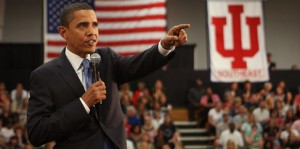How Much The College Loan Interest Rate Hike Would Cost You

Scott Olson / Getty Images
Then-Senator Obama addresses a town hall forum during a presidential campaign stop at Indiana University Southeast in April 2008.
Federal lawmakers can’t agree on how to pay for legislation that would prevent student loan interest rates from doubling. The measure stalled in the U.S. Senate this week.
President Obama has made the $6 billion measure a “top domestic priority,” Politico writes, saying it would save the average borrower roughly $1,000 of debt. Presumptive GOP presidential nominee Mitt Romney also supports the measure.
But crunching the numbers for a New York Times editorial, Mark Kantrowitz and Lynn O’Shaughnessy say that savings number is closer to $761 for the average borrower. Stretching that out over the life of a ten-year loan, that means borrowers save how much on a monthly payment?
“$6 a month extra for one year of loans” on average, they write:
The Stafford debate is more rhetoric than substance. If the rate on the subsidized Stafford loan program does double, as scheduled, to 6.8 percent this summer, very little will happen…
Let’s look more closely at what’s on the table. The proposals that Congress has been debating would extend the 3.4 percent interest rate for only one year. If a student borrowed the average subsidized Stafford loan ($3,357) at 6.8 percent for the next school year, the higher interest rate would boost the borrower’s debt burden by $761 over a 10-year repayment period. Even if the interest rate doubles, the monthly payment on the subsidized Stafford loan would increase by only about one-sixth…
Congress often passes this sort of legislation with a 5- or 10-year window, so it’s reasonable to ask whether this political battle was anticipated by Congressional Democrats, who knew they would gain political brownie points if the Republicans, in the months preceding a presidential election, balked at extending the low rate.
As we’ve written, the bigger issues of college cost don’t go away regardless of whether this interest rate measure passes.
It’s like Nick Hillman, a professor of higher education policy at the University of Utah, told StateImpact last month:
We’ve moved away from a system of grants to one of loans and tax credits. This is a demonstration of our policy values where we want to put more of the responsibility on the individual students, so taking out debt is becoming an expected thing to do.
It might not be a bad thing. Taking out debt to pay for a portion of school might not necessarily be a bad public policy option, it might actually help a lot of people enroll in college. But it’s when that debt burden hits that tipping point where it becomes unmanagable, it becomes burdensome, it becomes inequitable for certain borrowers, then you start to have a problem. That’s what we’re starting to see.
